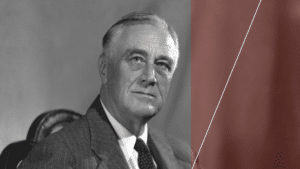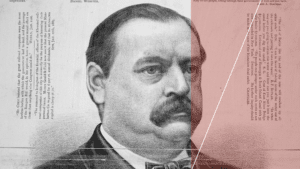Can a Former President Run Again After Serving Two Terms
In the original constitution, there was nothing written well-nigh how many terms a president could serve. All the same, after the 22nd amendment was passed, it became clearer.
How many terms can a president serve?
How long is a presidential term?
Co-ordinate to the constitution and the 22nd subpoena, a president can only serve for two terms. The length of a presidential term is 4 years.
A President's Term
Some leaders of countries seem to have an indefinite menstruation of rule. In Russian federation, Putin has been in charge for nearly x years. Chancellor Angela Merkel of Germany has been in power for 5143 days at the time of writing.
In the U.s., there are Constitutional laws to stop one person from holding as well much power for likewise long.

So, how long tin can you exist president for and when did this rule come into play?
How Long Tin can A President Serve?
Under normal circumstances, a president can serve viii years. The 8 years is split up into 2 terms of iv years each.
The electric current constitution with amendments states that a president can serve a iv-yr term from the inauguration and seek re-election. If they are successful in gaining a second term, they are non allowed to run for office again after finishing the second term.
Instead, the party must discover a new nominee and campaign for them with the endorsement of the current leader.
Exceptions to the ii Terms Dominion
Yet, there are some cases where this isn't quite so straightforward.
Some presidents don't outset their journeying as President-Elect but instead enter office mid-term. Likewise, terms don't accept to exist consecutive and this two-term dominion wasn't always in force.
How Did Franklin D. Roosevelt Serve More Two Terms?
We are used to presidents serving for 4 years, seeking re-election, and and then passing the billy on at the stop of a second term. Still, this hasn't always been the example.

Political and social changes tended to allow for a natural line of succession every bit different parties took power and new faces became the all-time candidates. FDR was the exception to the rule.
Franklin D. Roosevelt served 4 terms as president
Franklin D. Roosevelt was elected into office four times, although he only served a fraction of the quaternary earlier his death. His popularity and the success of his policies throughout his presidency meant that he could easily seek re-election with the support of the party and voters.
His full presidency ran from March 4, 1933, to Apr 12, 1945, which saw the nation past the Depression, through the New Deal, and into the Second Globe State of war.
In total, that meant three full terms and one partial term. He was elected for a quaternary simply died after merely ii months and 23 days into his fourth term.
Did Any Other President Try For A 3rd Term?
The rule about limiting the president to ii terms came into the constitution and so late, yous would wait to see more 3-term presidencies before on. But, this wasn't the example and Roosevelt was the only ane to do so. This is because of a combination of factors regarding the health and popularity of ii-term presidents.
There was also an unwritten agreement to stick to two terms. The idea of a 2-term limit had been effectually since the Constitutional Convention and both George Washington and Thomas Jefferson were said to be in favor. James Madison, James Monroe, and Andrew Jackson all decided to continue with the principle.
This wasn't the case for everyone though, as at that place were presidents that wanted to continue. Ulysses Southward. Grant was one of them and made different attempts to exercise so. There was an initial program to stay on and endeavor for re-election for a consecutive third term in 1876 simply negative opinion persuaded him not to. Yet, he put himself up for nomination in 1880 and lost to James Garfield.
What changed to limit the president to 2 terms?
In order to end this sort of extreme presidential run from happening once more after Roosevelt, the country needed an amendment to the constitution. The 22nd Amendment states that
"no person shall exist elected to the office of the President more than than twice"
This came from Firm Articulation Resolution 27 following the death of Roosevelt. Information technology took iii years, 343 days for the ratification procedure to reach completion on Feb 27, 1951.

At that place was a vital caveat to this amendment that affected the presidency of current president Harry Due south. Truman. Because he was the incumbent president and the subpoena was to apply to futurity presidents, he could accept served more than 2 terms. Withal, this important grandpa clause ended up being unnecessary. Truman could have sought re-election in 1952 even though he served one full term and most of Roosevelt'southward fourth. But, his approval rating of 27% was enough for him to stride aside.
Tin A President Serve For More Than eight Years?
This is where things get a little more than complicated. A presidential term is fixed to 4 years with the Inauguration taking place on the aforementioned date, Jan 20th. This means that two full presidential terms add together up to 8 years and no more. It is also interesting to measure out the length of a president's fourth dimension in role by day. All 2-term presidents served for ii,922 days apart from Washington'south 2,865.
Washington took power before information technology was decided to accept all terms begin on the 4th of March. This subsequently switched to the 20th of January. However, there is a potential situation where a president could serve for 10 years. It all depends on how they come to power.
The 25th Amendment is a smashing tool to protect the office of the president and ensure that the right person is in charge at all times. In that location are plenty of examples of presidents that didn't see the stop of their term. Impeachment, decease by natural causes, and assassination all meant that the nation could accept been without a leader until the next election if in that location wasn't someone to fill up in. This part typically falls to the vice president, unless there is practiced reason to go further downwardly the line of succession.
A vice president may be sworn-in directly afterward the death or removal of a president from office so seek to be nominated as the political party candidate at the adjacent ballot.
The second clause of the 22nd amendment states the following:
"no person who has held the role of President, or acted as President, for more than two years of a term to which some other person was elected President shall be elected to the office of the President more one time"
Therefore, equally long every bit that original partial term didn't exceed ii years, presidents are then free to stand over again afterwards a successful full term. The opportunity is in that location for a ten-yr term. However, this has never happened. There are a few cases of presidents that took over mid-term and went on to be elected themselves but none went any farther for various reasons.
Lyndon B. Johnson's Potential For A 9-Year Term.
The best example of a modern-mean solar day president to come close to this achievement is Lyndon B. Johnson. Johnson originally came to power from his office as vice president. Kennedy was assassinated 1 yr, i calendar month, and 29 days into his second term and Johnson took over immediately.
After completing this term, Johnson was re-elected by a landslide in 1964. The rule on the length of the partial term meant he was immune to run again in 1968. This was considered, just Johnson ultimately pulled out due to a combination of health and political reasons. There were fears about his heart and his handling of the Vietnam War.
Do Presidential Terms Have To Exist Sequent?
No rule states that a president must take on their 2d term in function directly after their starting time. However, it is rare to meet non-consecutive terms in office. For a start, many of the presidents of the menstruum of the late 20th and early 21st century were successful in their bid for directly re-ballot.
Earlier Trump became unsuccessful in his try for re-ballot, iii presidents were able to achieve 2 consecutive terms. Bill Clinton won the election of 1992 and stayed until 2000. Here power switched parties with Bush Jr. taking the presidency. In 2008 Bush had to step downward and his successor fought for election confronting Barack Obama. Obama stayed in power until 2016 when Trump won his ballot.
Grover Cleveland's Not-Consecutive Terms.
Presidents that lose their re-election bid are perfectly entitled to attempt again afterwards on in life. Those 8 years in ability could be pretty far apart, equally long as the aforementioned person doesn't stay in function for more than than those two terms. In that location have been plenty of attempts to get dorsum into power at a later engagement, merely only one was successful.

Grover Cleveland came to power on March 4, 1885, and served his full four-year term until 1889. He had lost the bid for re-election in the 1888 ballot. Just, that didn't stop him from trying once again in the next race. Non just did he attain the party nomination but the public voted him back in during the 1892 ballot. He would then serve his 2nd total term – equally the 24th President of the United States – from March 4, 1893, to March 4, 1897.
Presidents That Tried For Non-Consecutive Terms And Failed.
It is a tough process to win back the trust of a party and supporters after one failed attempt, especially if a political landscape evolves across the ideas that got you into power. Some old presidents have tried to become dorsum to their party and return to the office, while others evolved in a different direction.
Martin Van Buren's Attempt To Regain The Democratic Nomination.
Van Buren was i of a small number of presidents that did not retire gracefully and go out politics to younger men. He was upwardly for re-ballot in 1840 but lost, leading him to retire. Dissatisfied with the upshot, he came dorsum to political life in 1844 to fight for the nomination.
He came close but lost to Polk. By the time the 1848 ballot came around, in that location was growing tension between Van Buren and the Democratic Political party, and his chances of nomination were even slimmer. Then, he decided to run as a candidate for the Free Soil Party. This got him on the ballot once more for the first time in 8 years just didn't earn him many votes.
Teddy Roosevelt's Attempt To Remove Taft From Power.
One of the most interesting cases of a president trying their luck numerous times is that of Teddy Roosevelt. His initial run consisted of a partial term of 3 years, 5 months, and 18 days and so one full term following his election.
At this point, Roosevelt passed the torch to Taft and declined to run for a 2d total term. At this point in history, it would have been fine co-ordinate to the constitution for him to keep. The problem was that he regretted his endorsement afterward Taft's election in 1908, which led him to claiming Taft for the nomination in 1912.
Taft retained the Republican nomination, and so Roosevelt tried a dissimilar approach to oust him from power. He formed the Bull Moose Political party (officially known every bit the Progressive Party) to claiming as a third-party independent. The vote was split leading the Democrat Woodrow Wilson won the race.
Could Nosotros See Non-Consecutive Presidential Terms Again?
1 of the curiosities about the rules for running for president is that there is a lower age limit of 35 only no upper limit. Therefore, in that location is nothing to stop one-time unmarried-term presidents from running again 4 or even viii years after a failed bid. The flip side to that is that you now have presidents that are already quite erstwhile when they take office for the showtime time. This limits the chances of any interesting campaigns for non-sequent terms in the time to come.
At the moment, nosotros have two living former presidents that served a single term and could theoretically come back. The odds of Jimmy Carter getting dorsum into politics are incredibly depression given that he is 97. There is always speculation about Donald Trump trying once again in 2024, at which point he would be 77. Then there is Joe Biden, who is already 79 in his outset yr in role.
Two-term Presidencies Are Here To Stay.
The two-term rule may be a piffling more than circuitous than information technology first appears, but information technology is an essential part of presidential rule in the United States. Even before the ratification of the 22nd Amendment, there was that unwritten agreement that two terms were more than plenty. This is unlikely to ever change.
Source: https://constitutionus.com/presidents/how-many-terms-can-a-president-serve/
0 Response to "Can a Former President Run Again After Serving Two Terms"
Post a Comment